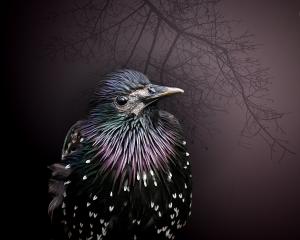
Wyoming hardly feeds the starlings' cause,
Yet they thrive in cold scarcity, feast
On their own raucous noise.
Murky harbingers of black-winged fortune,
In cold scenery they thrive, live for months,
Neatly crowded, poised for each cherry-blue sunrise.
Glinting eyes remain curious but cocky.
Starlings hone in on every bird feeder,
They balance on each smooth fence, like
Angels, but tattered, black, more than a little
Ragged, but talkative, friendly,
Linked to each other by same oily feathers, leaning
In perfect unison against each other,
Neatly informing each other of imminent snow.
Granted, ice hardly fazes their blunt fearlessness.
Scrappy, they remain like oil on water,
Ingenious, independent, they do not mix or mingle,
Never speak well of other birds,
Gathering in congregations more like gossip groups,
Razz and tease other starlings,
As if they wished to repeat middle school
To establish eternal patterns of prating.
In summary, they are no strangers to exclusion
And segregation, short shrifts, or ice-encrusted looks askance.
They are bustling bundles of energy,
Eager to spill the black beans.
Then winter frost sidles in, almost their friend.
How they find strength in numbers, beat back numbness,
Even nullify November winds,
Make small talk through December's deep freeze,
So that January's thick-cut rind of ice
Enjoins only one starvation diet that
Lessens after February's formation of ice-walled resistance.
Varieties of freezing do not stymie them,
Ease in defying dwindling light marks their resilience.
Starlings appear ravishingly roguish in spring.
To birdwatchers, their strut and stance
On perches, or while they scavenge branches, bushes,
Young trees, or plants, where these birds seem
Ornithologically industrious,
Unitedly loud and lustrous in stubborn stamina.
|




